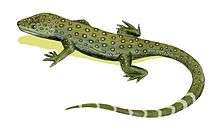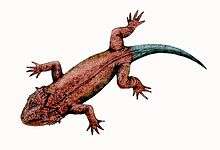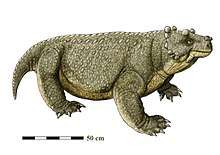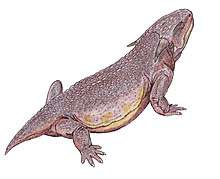Nycteroleteridae
Nycteroleteridae is a family of procolophonian parareptilians (extinct early reptiles) from the Middle to Late Permian of Russia and North America. They are sometimes classified as a sister group to pareiasaurids (but see Classification). The group includes the genera Macroleter, Bashkyroleter, "Bashkyroleter" mesensis, Nycteroleter, Emeroleter, and probably Rhipaeosaurus. They were carnivorous, and occasionally ate insects.[1] The group was most common in European Russia, with only a few fossils in North America. One fossil has also been found in Africa, but this is the only one from Gondwana.[2]
| Nycteroleteridae | |
|---|---|
 | |
| Adult and juvenile skulls of Macroleter (=Tokosaurus) | |
| Scientific classification | |
| Kingdom: | Animalia |
| Phylum: | Chordata |
| Class: | Reptilia |
| Clade: | †Parareptilia |
| Order: | †Procolophonomorpha |
| Clade: | †Pareiasauromorpha |
| Family: | †Nycteroleteridae Romer, 1956 |
| Genera[1] | |
|
†Bashkyroleter | |
Classification
Nycteroleteridae is sometimes considered a sister group to the Pareiasauridae, but Bayesian inference suggests that it was in fact paraphyletic, with Rhipaeosaurus a basal member of the Pareiasauridae and other members of the Nycteroleteridae as outgroups. This is supported by the appearance of Rhipaeosaurus' skull and teeth - it had tricuspid teeth and multiple horns on the skull, resembling a pareiasaur but smaller and with a longer tail. For this reason it is often seen as intermediate between more primitive nycteroleterids and more advanced pareiasaurids such as Scutosaurus.[2]
Features
As discussed above, Nycteroleteridae technically includes all pareiasaurs as well as the five given genera. Within the five genera mentioned, there seems to be a smooth gradient of form from Macroleter to Rhipaeosaurus. Where Macroleter has no horns,Emeroleter has a few small horns, and Rhipaeosaurus' horns are quite large.[2]
However, there are some characteristic features of the Nycteroleteridae. They have a deeply incised otic notch, postparietal bones that enter the pineal opening, regular circular pits in the skull, and a row of palatal teeth from the interpterygoid vacuity to the edge of the choana.[2]
Examination of the nycteroleterids' middle ear bones and comparison with living amniotes showed that they probably had efficient impedance-matching hearing. This suggests that they may have been active at night or in dim-light environments. They are thought to have been carnivorous or insectivorous, but Rhipaeosaurus may have been an omnivore.[2]
References
- Tsuji, L.A.; Müller, J.; Reisz, R.R. (2012). "Anatomy of Emeroleter levis and the Phylogeny of the Nycteroleter Parareptiles" (PDF). Journal of Vertebrate Paleontology. 32 (1): 45–67. doi:10.1080/02724634.2012.626004.
- "Palaeos Vertebrates Anapsida: Nycteroleteridae". palaeos.com. Retrieved 2018-02-16.






